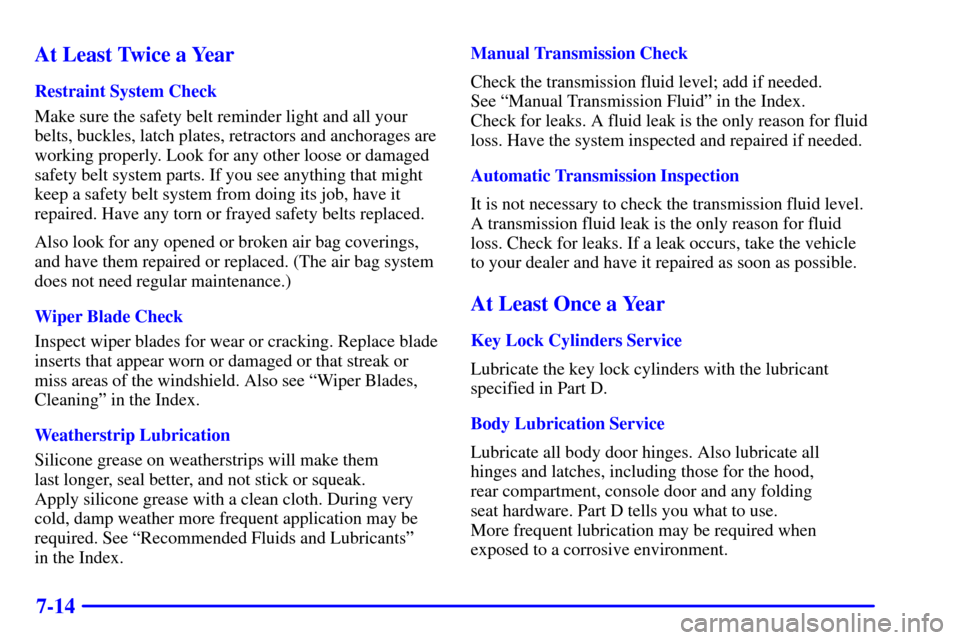Page 282 of 384
6-10 Hood Release
NOTICE:
In order to avoid possible contact of the hood to
the headlamp doors, either take care in raising
the hood with the headlamps up, or turn off the
headlamps prior to opening the hood.
To open the hood, do the following:
1. Pull the handle located
inside the vehicle below
the instrument panel
on the driver's side.
2. Go to the side of the vehicle and pull up on the rear
edge of the hood, near the windshield.
Before closing the hood, be sure all the filler caps
are on properly. Then, just pull the hood down and
close it firmly.
Page 283 of 384
6-11 Engine Compartment Overview
When you open the hood, you'll see the following:
A. Coolant Surge Tank and
Pressure Cap
B. Battery
C. Engine Oil DipstickD. Engine Oil Fill Cap
E. Engine Air Cleaner/Filter
F. Power Steering Fluid Reservoir
G. Brake Fluid ReservoirH. Clutch Master Cylinder
Reservoir (If Equipped)
I. Windshield Washer
Fluid Reservoir
Page 306 of 384
6-34 Headlamps
1. The headlamp doors need to be halfway open.
Turn the headlamps on, then quickly back to the
parking lamps setting. You may have to do this a
few times to get the half
-open position.
You can also open the headlamp doors manually by
turning the adjuster counterclockwise.
2. Remove the screws on each side of the headlamp bezel.
3. Open the hood.
4. To remove the bezel, pull the sides slightly outward
and tilt the bezel forward. Pull the clip centered
above the lens outward. Be careful not to scratch
the paint on the vehicle.
Page 310 of 384

6-38
Windshield Wiper
Blade Replacement
Windshield wiper blades should be inspected at least
twice a year for wear or cracking. See ªWiper Blade
Checkº in the index for more information.
Replacement blades come in different types and are
removed in different ways. For the proper type and
length, see ªNormal Maintenance Replacement Partsº
in the Index.
It's a good idea to clean or replace the wiper blade
assembly every six months.
NOTICE:
Use care when removing or installing a blade
assembly. Accidental bumping can cause the
arm to fall back and strike the windshield.
To remove the wiper blade assembly:
1. Open the hood to gain access to the windshield wipers.
2. Lift the wiper arm until it locks into a vertical position.
A. Blade Assembly
B. Arm Assembly
C. Locking TabD. Blade Pivot
E. Hook Slot
F. Arm Hook
3. Press down on the blade assembly pivot locking
tab (C). Pull down on the blade assembly (A) to
release it from the wiper arm hook (F).
4. Remove the insert from the blade assembly (A).
The insert has two notches at one end that are locked
by the bottom claws of the blade assembly. At the
notched end, pull the insert from the blade assembly.
Page 362 of 384

7-14 At Least Twice a Year
Restraint System Check
Make sure the safety belt reminder light and all your
belts, buckles, latch plates, retractors and anchorages are
working properly. Look for any other loose or damaged
safety belt system parts. If you see anything that might
keep a safety belt system from doing its job, have it
repaired. Have any torn or frayed safety belts replaced.
Also look for any opened or broken air bag coverings,
and have them repaired or replaced. (The air bag system
does not need regular maintenance.)
Wiper Blade Check
Inspect wiper blades for wear or cracking. Replace blade
inserts that appear worn or damaged or that streak or
miss areas of the windshield. Also see ªWiper Blades,
Cleaningº in the Index.
Weatherstrip Lubrication
Silicone grease on weatherstrips will make them
last longer, seal better, and not stick or squeak.
Apply silicone grease with a clean cloth. During very
cold, damp weather more frequent application may be
required. See ªRecommended Fluids and Lubricantsº
in the Index.Manual Transmission Check
Check the transmission fluid level; add if needed.
See ªManual Transmission Fluidº in the Index.
Check for leaks. A fluid leak is the only reason for fluid
loss. Have the system inspected and repaired if needed.
Automatic Transmission Inspection
It is not necessary to check the transmission fluid level.
A transmission fluid leak is the only reason for fluid
loss. Check for leaks. If a leak occurs, take the vehicle
to your dealer and have it repaired as soon as possible.
At Least Once a Year
Key Lock Cylinders Service
Lubricate the key lock cylinders with the lubricant
specified in Part D.
Body Lubrication Service
Lubricate all body door hinges. Also lubricate all
hinges and latches, including those for the hood,
rear compartment, console door and any folding
seat hardware. Part D tells you what to use.
More frequent lubrication may be required when
exposed to a corrosive environment.